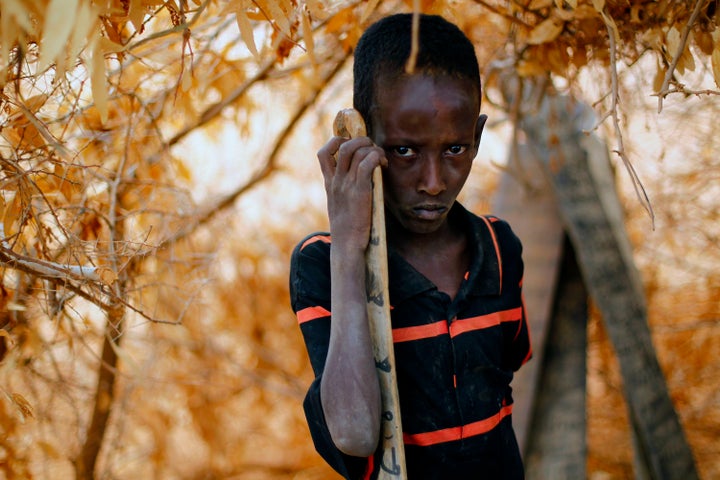
During a recent trip to Kenya, I met a young boy named Lomoru. He told me that he was about four years old the last time a good rain came to his village. Now, a decade later, the barren road to the remote part of northern Kenya he calls home bears the scars of so many seasons without rain. The earth is parched and the sandy soil a fine powder. Wide river beds stand dry and empty herds of camels and goats, tired and emaciated, wander the sere countryside in search of food and water. More than 12 million people living within the Horn of Africa are at risk of starvation. Many have already succumbed.
Over much of the region, a familiar sequence of past droughts has already played out. With failed crops and no income, families turn to selling their possessions, first the modest household items followed by furniture and other possessions. Next they take what they can for their livestock. Finally, with no reason to stay, they sell the corrugated roofs from their houses, turn their backs to the remaining walls and set off to seek shelter elsewhere.
The disheartening pattern repeats itself thousands of times over: drought, selloff, migration. It's what orchestrates the scenes of millions of starving people on desperate marches of hope.
But Lomoru is not among them.
When I visited the 14-year-old in the village of Kalemunyang a few weeks ago, I was astonished by what I saw. Emerging from the barren terrain that dominates the landscape beyond the village was an expanse of green, an oasis of vegetation glistening in the mid-day sun. The lush gardens stood in stark contrast to the surrounding environs, especially in the midst of a drought of epic proportions. And yet, here I was, strolling amid acres of "shambas" (vegetable gardens) where local women tended to spinach, tomatoes, green peppers, okra, watermelons, kale, maize and snow peas.
I had not expected it, or at least not the extent of it. I had anticipated that I would encounter many changes in the 30 years since I spent my early Peace Corps days in Kenya. The country has a special place in my heart -- it's where I was married and where my son was born a few years later. I knew the drought had hit the country hard, and I was braced for widespread devastation and despair.
And there certainly was plenty of it. Much of Kenya has not been spared the impact of another season without precipitation. Nor has Kalemunyang. But the village has immunized itself against the ravages of drought through its participation in an innovative program that provides families with food and goods in exchange for their work building irrigation systems and community gardens. Funded by the United Nations' World Food Program and administered by ChildFund International, the Food for Assets program has taught the villagers of Kalemunyang how to feed and sustain themselves, not only taking advantage of irrigation from the nearby Turkwel River but also by teaching people how to use special pans to catch the rare sprinkles of rainwater. This access to water has meant higher crop yields and more pasture for livestock as well as reduced environmental degradation.
School attendance also is up. After ChildFund helped pipe water from the community borehole to the school, new toilet facilities were built, which has considerably improved attendance rates, especially among girls. Improved education -- which still has a long way to go, given the dearth of teachers -- offers the best path toward long-term success and self-sufficiency.
Which brings me back to Lomoru. He shakes my hand with the confidence of someone much older, belying his 14 years and leaving me no doubt he will achieve his ambition of someday becoming a judge. But it is only by virtue of where he lives -- this green oasis feeding itself amid catastrophic conditions -- that he is able to even consider such dreams. Not all that far away, thousands of other would-be judges -- or teachers or doctors or farmers -- have dreams that do not extend beyond the next day, the next meal.
The situation in the Horn of Africa is as complicated as it is dire, and there are no easy solutions. Extending the Food for Assets programs to more villages, for example, would take many years and considerable funding. And yet, amid the despair and suffering that is so widespread throughout the region, the success of this program in villages like Kalemunyang provides a model that works, not just in the near term, but over time. Importantly, it is turning pastoralists into agriculturists, giving families a source of food, not only for themselves but their livestock.
That success, however isolated, should not be discounted. In order to reduce the impact of drought on a region where seasonal rains have become more the exception than the rule, such programs may offer the best hope for giving Lomoru and the generations to follow the best hope for a sustainable future.